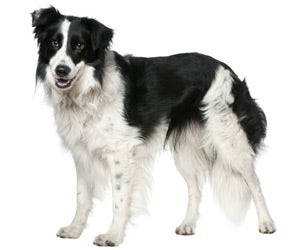Border Collie
-
Overview
Border Collies are intuitive herding dogs who love being given a task to complete. They live up to their reputation as the smartest dog breed by quickly responding to training and excelling in canine sports and obedience. They are a light-weight, agile dog who stands between 1 ½ feet and almost 2 feet tall and weighs between 30 and 45 pounds.
-
Personality
-
Coat Care

Bordor Collie's weather-resistant coat needs to be brushed and combed weekly with a metal comb, to remove tangles, and a slicker brush, to remove dead hair. Brushing helps distribute protective oils throughout the coat and prevents matting, especially in rough-coated Border Collies. They shed seasonally, so frequent brushing will help reduce the amount of hair that they lose around the house.
Bathe your Border Collie about once every four months.
Clipping or trimming your dog’s coat is far easier than you would ever imagine. With the right clipper, trimmer and scissors, giving your dog a haircut is easy on your wallet and your schedule.
Dogs with combination coats generally require routine trimming. It lessens the chances of matting, tangles and the infestation of fleas and other pests, thus reducing the risk of skin infections. There is no set timetable. Judgment should be made on an individual basis, depending on functionality and owner preference. There are a wide array of trimmers available that will make each snip a snap. It’s a good idea to take your dog for a short walk to calm him down before you groom him. Thoroughly brush the coat to remove tangles and mats. Use trimmers to trim excess fur off the dog's body, choosing the appropriate clip attachment to achieve desired length. Start with the shoulders and progress towards the tail. Use a trimmer or a scissors to even out areas around the tail, paws, sanitary areas and chest, as needed. Groom the head and face last, being watchful for sudden movement. Trim with the flow of the fur, away from the eyes and nose.
Many dog owners are apprehensive about trimming their dog’s nails because they are nervous about cutting into the quick. But with the right conditioning and careful cutting, nail clipping can be a simple, stress-free activity for you and your dog.
Provide your dog with plenty of positive reinforcement and even treats to help associate nail clipping with a positive experience. As you start to clip, gently press on your dog’s paws to help him become accustomed to the feeling of having his nails clipped. Then, work gradually, shaving down just a thin portion of the nail at first to make sure you don’t reach the quick. Clip one nail, reward your dog with a treat, and stop to give him some positive reinforcement before moving on. Gradually increase the number of nails you clip in one sitting to help your dog get used to the process. Never trim extremely long nails down to a short nail in one sitting, because this is an excellent way to accidently quick the dog’s nail. Instead, work gradually, shaving small portions of your dog’s nails off each time.
You can tell if you’re getting close to the quick by the texture of your dog’s nail. The nail is hard closer to the surface and becomes softer as you get closer to the quick. If your dog’s nail starts to feel softer, that’s a good indication that you’re getting close to the quick.
Not all breeds and coat styles require routine trimming in and around the eyes and ears but all should undergo regular inspection and cleaning around these sensitive areas. Doing so will help prevent the development of infections that could seriously damage these amazing organs.
It is always important to routinely clean your dog's eyes and ears, and examine for potential infections. Small dogs, like Dachshunds, Cavalier King Charles Spaniels, Papillions and Japanese Chins, and dogs with hanging ears like the Saluki, have sensitive ears that need to be checked weekly for infection and cleaned with a cotton ball. Gently wipe a cotton ball moistened with mineral oil, olive oil or witch hazel in your dog's ear, being careful to avoid the ear canal. Never use a Q-Tip, which could cause damage to the inner ear if your dog suddenly shakes or jerks his head. Bushy hair growth within the ear can be thinned with tweezers or blunt scissors. Use a small trimmer to trim excess hair around the eyes, ears and face. Small dogs like Papillions and Cavalier King Charles Spaniels are prone to developing tear stains around their eyes, so clean around their eyes with a cotton ball or soft cloth and use a small trimmer to trim excess hair around their eyes.
Brush their teeth twice a week.

 India (English)
India (English)
 Middle East and Africa (English)
Middle East and Africa (English)
 South Africa (English)
South Africa (English)
 Australia (English)
Australia (English)
 Japan (日本語)
Japan (日本語)
 South East Asia (English)
South East Asia (English)
 Singapore (English)
Singapore (English)
 Europe (English)
Europe (English)
 United Kingdom (English)
United Kingdom (English)
 Argentina (Español)
Argentina (Español)
 Brazil (Portuguese)
Brazil (Portuguese)
 Colombia (Español)
Colombia (Español)
 Latin America (Español)
Latin America (Español)
 México (Español)
México (Español)
 Chile (Español)
Chile (Español)
 Peru (Español)
Peru (Español)
 Canada (English)
Canada (English)

